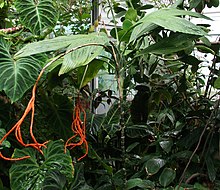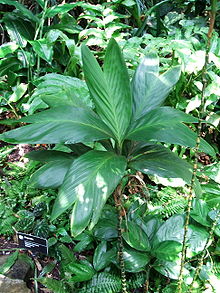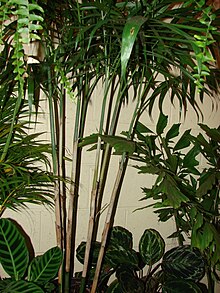Mountain palms
| Mountain palms | ||||||||||||
|---|---|---|---|---|---|---|---|---|---|---|---|---|

|
||||||||||||
| Systematics | ||||||||||||
|
||||||||||||
| Scientific name | ||||||||||||
| Chamaedorea | ||||||||||||
| Willd. |
The mountain palms ( Chamaedorea ) are a genus of palms native to South America . They are rather small, often clump-forming diocese palms.
features
The palms are small, rarely medium-sized, upright or prostrate, rarely climbing. A trunk can be formed or hidden underground. They are single-stemmed or clump-forming, unarmed and diocesan. The trunk is usually slender, completely or partially covered with the fibrous leaf bases or with smooth, green, conspicuously ringed leaf scars.
leaves
The leaves are bifid or pinnate in various ways. They are also seldom undivided. The leaf sheath is closed or torn, it is short or long and sometimes has a drying lobe opposite the petiole. The petiole is short to long, flattened on the upper side, rounded on the underside and sometimes has a striking light green or yellow stripe here. The leaf blade is undivided, in two parts and then ribbed pinnately, or regularly or irregularly pinnate. There are then few to numerous leaflets that are folded once or several times. They are narrow to wide. Their surface is bare.

Inflorescences
The inflorescences are between or under the leaves. One or more inflorescences arise per leaf axil. They are unbranched or branched once or rarely twice, sometimes bifurcated. The male inflorescences are often more branched than the female. The peduncle is short to long. The cover sheet is tubular with a two-part tip. There are two or more bracts on the peduncle. These are elongated, tubular and sheath the inflorescence stalk. They are leathery or membranous, persistent, with a short tip. The flower-bearing side branches (rachillae) are short to long, slender or fleshy, sometimes furrowed and do not have bracts at maturity. On them are either male or female flowers close or wide in a spiral arrangement.
blossoms
The flowers are sessile or partially sunk in a pit of the fleshy rachilla. They are small to very small.
The male flowers are symmetrical. The three sepals have entire margins and can be fused together in the lowest area. The three petals are free or grown together to varying degrees. The corolla lobes are valvat . The six stamens have short stamens and are broad or awl-shaped. The stamen attaches to the back of the anther (dorsifix). The rudiment of the stamp is cylindrical or widened below, and sometimes three-lobed. The pollen is ellipsoidal, sometimes slightly triangular, bisymmetrical, or slightly asymmetrical. The germ opening is a distal sulcus . The longest axis measures 20 to 35 microns.
The calyx of the female flowers resembles that of the male flowers. The petals are mostly fused, the lobes are valvat or imbricat (overlapping like roof tiles). The staminodes , if present, are tooth-shaped. The gynoeceum is egg-shaped, consists of three fused (syncarpic) carpels that form three fruit compartments. The scars are small and bent back. The ovules are campylotropic and attach laterally.
fruit
The fruits are small and spherical to elongated. The scar remains are basal. The exocarp is smooth, the mesocarp fleshy, and the endocarp thin. The seed stands upright, is spherical or ellipsoidal. The scar (hilum) is small. The endosperm is cartilaginous. Most fruits contain calcium oxalate crystals.
Distribution and locations
The representatives come from Mexico south to Brazil and Bolivia. All species are representatives of the undergrowth of moist, wet forests in the lowlands or - most of the species - in the mountains. Some species occur over limestone.
Systematics
The genus Chamaedorea is placed within the family Arecaceae in the subfamily Arecoideae , tribe Chamaedoreeae . The genus is monophyletic . She is the sister group of Gaussia .
The genus includes around 104 species. For a complete list, see the World Checklist of Selected Plant Families at the Royal Botanic Gardens, Kew.
The genus was divided into eight sub-genera by DR Hodel in 1992. The two most species-rich subgenus are, however, polyphyletic , and the rest are not all monophyletic.
The name Chamaedorea is derived from the ancient Greek words for dwarf and gift and, in addition to the small size, possibly refers to the elegant growth form of many species.
use
The inflorescences of some species such as Chamaedorea tepejilote are used as vegetables. The leaves are used for roofing and also in the cut flower trade. Some species are grown as potted plants and produced in large quantities. Chamaedorea elegans is probably the most common indoor palm.
The fronds of Chamaedorea elegans , Chamaedorea oblongata and especially Chamaedorea ernesti-augusti are widely used as leaf greens in the flower industry under the name “Xaté”, as they stay fresh for up to 45 days after harvest. It is estimated that around 400 million stems are exported annually from Guatelama and Belize, mainly to North America and Europe. To this day (as of January 2012) there are hardly any Xaté plantations, so that the wild collection of the stalks means increasing stress on the rainforests, some of which are protected.
literature
- John Dransfield, Natalie W. Uhl, Conny B. Asmussen, William J. Baker, Madeline M. Harley, Carl E. Lewis: Genera Palmarum. The Evolution and Classification of Palms . Second edition. Royal Botanic Gardens, Kew 2008, ISBN 978-1-84246-182-2 , pp. 377-381.
Individual evidence
- ^ Robert Lee Riffle, Paul Craft: An Encyclopedia of Cultivated Palms. 4th edition. Timber Press, Portland 2007, ISBN 978-0-88192-558-6 , p. 294.
- ↑ Rafaël Govaerts (ed.): Chamaedorea. In: World Checklist of Selected Plant Families (WCSP) - The Board of Trustees of the Royal Botanic Gardens, Kew . Retrieved August 4, 2018.
- ↑ Argelia Cuenca, Conny B. Asmussen-Lange: Phylogeny of the Palm Tribe Chamaedoreeae (Arecaceae) Based on Plastid DNA Sequences. In: Systematic Botany. Volume 32, 2007, OCLC 842589638 , pp. 250-263.
- ^ Robert Lee Riffle, Paul Craft: An Encyclopedia of Cultivated Palms. 4th edition. Timber Press, Portland 2007, ISBN 978-0-88192-558-6 , p. 296.
- ↑ Boris Jarosch: Greetings from the rainforest ... 2012. # 93; = 13 & cHash = e2dd12f15f86069f8064057ec2841096 (online at: environmentalists.de ) ( Memento of the original from December 12, 2013 in the Internet Archive ) Info: The archive link was automatically inserted and still Not checked. Please check the original and archive link according to the instructions and then remove this notice.
further reading
- DR Hodel: Chamaedorea palms: the species and their cultivation . International Palm Society, Kansas 1992.








